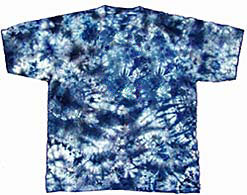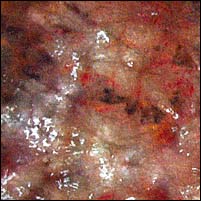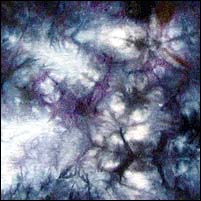
This is a form of "low immersion" dyeing that results in a sharp distinct crystalline looking pattern. Unless you have teeny buckets, this works best with an adult tee or larger garment or piece of fabric. Basically, whatever you are dyeing, you need a container small enough that it will be a tight fit when scrunched in. The pattern will usually be more distinct than "low immersion" or "baggie dyeing", where the fabric is looser. There are great instructions for traditional low immersion dyeing that many quilters prefer in the book Color by Accident by Ann Johnston. It is excellent! She goes into gradation so that you can dye many squares of fabric from light to dark, or from one color to the next.


How to do it:
Step 1: Soak 100% cotton shirt (or fabric or whatever) in Soda Soak solution, follow Step 2 of our Tie dye directions - wring out excess.
Step 2: Lay the garment flat on a protected surface and use your fingers (in gloves) to sort of bunch it together into a flat scrunched round biscuit shape.
Step 3: Cram the garment into the bottom of a very small bucket or other container. It needs to be very tight. If this is not possible, put rubber bands all around it so it is like a big pie.
Step 4: Squirt on 1 or more colors of Procion Fiber Reactive dye mixed up according to the Tie dye directions.
Step 5: If you want white in the areas where the dye doesn't penetrate, for strong contrast, just let it sit 12-24 hours, then wash out as recommended in our Tie dye directions.
Step 6: If you want lighter color (instead of white) in the areas where the dye doesn't penetrate, push on the garment a little with a stick or gloved hands to push some of the dye in deeper.
Cool Variations


How to do it:
Step 1: Instead of soaking the shirt in Soda Ash solution, soak it thoroughly just in water, then scrunch it up on a protected flat surface and rubber band it as above. Put it in a bucket or plastic tub.
Step 2: Dissolve a 1/2 cup or so of soda ash in some warm water - however much it takes to dissolve it.
Step 3: Carefully sprinkle pure dye powder (cheap plastic salt shakers work very well!) in several different colors on one side of the shirt- aim for "non-uniform coverage". Wear a dust mask!!! For a "rock effect" use several different shades of browns and greys, or for a "water effect" use several shades of blues and aquamarines. You get the picture. Use colors that mix well together, and don't just make "mud".
Step 4: After 2 or 3 colors of powder, carefully pour on just enough "soda ash water" to get the dye wet that you just put on, then sprinkle on a couple more colors, then more soda ash water. You can use up to 5-7 colors total.
Step 5: Carefully drain the excess soda water and dye that has accumulated in the bottom of the bucket, flip the garment and repeat Steps 3-4. Don't be alarmed if the garment just looks like a muddy mess! Drain the excess at the bottom of the bucket again. Push on the garment with a stick or gloved hands to push some of the dye in deeper.
Step 6: Leave it sit 12-24 hours, then wash out as recommended in our Tie dye directions.
Step 7: If the garment ends up with too much white on it, you can then re-scrunch the garment, rubber band it, and dye it in a light colored dye bath according to our Tub dyeing directions. Use a color that goes with all of the others you have used.
If you follow this technique carefully, you will be amazed at the incredible variation and complexity of colors and pattern you end up with!











